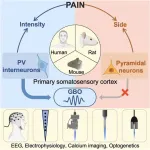(Press-News.org) In brief
In their overview study, the team of researchers led by Russell McKenna identified 14 key impact categories of wind energy.
They provide possible solutions for the identified impacts and suggest research priorities. More than 400 studies were included in the analysis.
The review paper, recently published in the journal Joule, provides guidance for future studies and policy decisions.
What is the study about, and what is its core message?
Russell McKenna: The study looks at the impacts of wind energy on the systems in which it is embedded; whether environmental and climate systems, socio-economic, techno-economic, or political-legal systems. We looked at the current state of research and tried to distinguish where the picture is relatively clear and where challenges (still) need to be overcome. We defined a total of 14 impacts to show where research priorities should lie to overcome some of these challenges.
What specific impacts are there? Can you give us some examples?
In the area of environment and climate, for example, the effects of wind farms on the local climate or the end-of-life scenario of rotor blades that cannot be recycled are considered. In the socio-economic systems, we have identified, among other factors, the local costs and benefits related to wind turbines. In the political-legal system, one example of a question is what happens if the supply chain is interrupted for geopolitical reasons.
How did you go about identifying these 14 impacts of wind energy?
Some background: we are 24 co-authors from different institutions, mostly involved in a three-year project funded by the European Commission called WIMBY, which stands for “Wind In My Backyard”. As part of this project, we wanted to conduct a holistic analysis of wind energy and create an inventory of the various impacts of wind energy on different systems. We conducted a comprehensive literature review of over 400 studies and were thus able to identify the current state of the art and the priority research topics.
Which result surprised you the most?
There were some results that we found to be contrary to popular belief. One example is infrasound, low-frequency noise that is often mentioned as a problem by the public because it can cause irritation and even make objects in houses vibrate. However, research has produced only one study we know, examining a specific wind turbine. It was done about three decades ago when the first prototypes were just being built. No correlation with low-frequency noise can be demonstrated with today's turbines – but this has not yet become common knowledge.
Speaking of wind turbines: almost 60,000 installations will need to be replaced by 2030, and their rotor blades cannot be recycled. What approaches are there to avoid this problem in the next generation?
The fibre binder poses a problem when recycling the rotor blades. Indeed, thermoset plastics such as epoxy or polyester cannot melt, making glass fibre recovery nearly impossible. As a result, most blades are currently crushed and landfilled or deposited in unofficial “interim storage” sites. Technologies such as pyrolysis (thermochemical treatment without oxygen) can help recover the blades’ fibres. Still, the resulting quality of the recovered material and the very low market price of the virgin counterpart make it an economically unattractive option. However, recently made blades have better prospects, as major manufacturers now use a resin that can be dissolved at the end of life, making it easier to free the fibres 20 years from now. A combination of approaches is thus being taken to recirculate as much material as possible. Finally, such burdens always need to be balanced against the co-benefits of wind energy expansion – one of them being the phasing out of fossil-based energy.
Where do you see the greatest need for action?
Clearly, the population's acceptance of wind turbines is key, as they do influence the landscape. We have had a similar situation with the existing grid infrastructure for decades. People want electricity to come out of the socket and rely on it daily. The electric grid is suspended from pylons across the landscape, which are sometimes not locally accepted. In other words, people want the (energy) service, but the “problem” of the impact should be somewhere else. It is similar for wind turbines: there is generally high acceptance in the population, for example, 60% of the Swiss population support wind in the future electricity mix, but local opposition is common. Evidence shows that people might be more willing to accept wind turbines if the community benefits, for example, through a financial stake in the project or if jobs are created for the local economy. These jobs are not just technical ones – believe it or not, wind farms can also be attractive locations for tourism. In general, a lot still needs to be done to educate the population about the relative advantages and disadvantages of wind power. A compromise is always required with all energy technologies, and it is unreasonable to focus on the disadvantages of one technology without considering the alternatives.
Which topics of the study are particularly relevant for Switzerland?
Almost all the topics identified are relevant to Switzerland, although we can probably exclude offshore wind farms. For example, in the techno-economic category, we look at how wind energy integrates into the energy system with storage, flexibility, grid enhancement and sector coupling measures. Switzerland has the advantage that its system has historically been heavily geared towards renewable energies; hydropower accounts for almost two thirds of the electricity supply. You can build on that experience and expertise with large amounts of non-dispatchable electricity generation. We also need integrated energy systems, which Switzerland already has with some of its neighbouring countries. However, tighter market integration will depend on the pending agreements with the EU.
Another point to highlight is the supply chains’ resilience to geopolitical developments. As far as I know, there are no Swiss manufacturers of wind turbines, which is a risk because we have to import the technologies. So, whilst we achieve more energy independence through domestic renewable energy supply, we increase the dependency on technology imports.
What is your personal highlight or something positive that you would like to emphasise?
I am proud of the table in the study. It distils more than 400 scientific studies and provides a comprehensive and concise overview. We have identified research priorities and highlighted possible solutions in a few key points. The table can also serve as a base for policymakers to address key challenges in accelerating wind developments. In addition, the table shows whether the impact depends strongly on the wind turbines’ location. If the dependency is high, the impact of wind energy differs a lot depending on location; other impacts are spatially rather homogenous.
What are the next steps?
We can look ahead now that we have been working on this study for almost two years. Ongoing work in WIMBY will help to address a lot of the challenges. For example, we are developing a Europe-wide map of landscape quality in the form of so-called “scenicness”. Based on crowd-sourced data from Great Britain, we have developed a machine-learning model to connect this parameter to other spatial characteristics such as remoteness, level of human impact and land use categories. This means we can estimate such indicators for regions where data is lacking. The result is imperfect, but it helps measure the quality of landscapes at the European scale, allowing us to consider such factors in wind farm planning. One main output from WIMBY will be interactive maps, where users can explore all sorts of data for any location in Europe and analyse the feasibility and impact of potential wind turbine farms.
Any final comments?
I want to emphasise that I am not in any way advocating for wind energy over any other technology. But I am a scientist conducting interdisciplinary research on energy technologies and systems. This research shows that these technologies all have advantages and disadvantages across a wide range of impact categories. Unfortunately, the discussion around the energy transition tends to focus on specific pros or cons and blend out the others. This and other studies have uncovered some of the “myths” around wind energy, by distinguishing them from real impacts and research challenges. It is crucial that all stakeholders, including the public, have the “full picture” in mind when trading off between diverse energy technologies.
About Russell McKenna
Russell McKenna is Professor of Energy Systems Analysis at ETH Zurich and Head of the Laboratory for Energy Systems Analysis at the Paul Scherrer Institute (PSI). His current research topics include the holistic assessment of energy technologies and systems, including resource assessments for low-carbon technologies, the development and application of energy system models at building up to global scales. Additional research interests relate to the socio-economic characteristics of energy consumption, scale effects in decentralised energy systems and energy system integration across sectors and applications.
END
“The biggest challenge is lacking public acceptance of wind turbines”
2025-01-13
ELSE PRESS RELEASES FROM THIS DATE:
Six-month outcomes in the long-term outcomes after the multisystem inflammatory syndrome in children study
2025-01-13
About The Study: The results of this cohort study suggest that although children and young adults with multisystem inflammatory syndrome in children (MIS-C) can have severe disease during the acute phase, most recovered quickly and had a reassuring midterm prognosis.
Corresponding Author: To contact the corresponding author, Dongngan T. Truong, MD, email truongd@kidsheart.com.
To access the embargoed study: Visit our For The Media website at this link https://media.jamanetwork.com/
(doi:10.1001/jamapediatrics.2024.5466)
Editor’s Note: Please see the article for additional information, including other authors, author contributions and affiliations, ...
Global prevalence of sexual violence against children
2025-01-13
About The Study: The findings of this systematic review and meta-analysis highlight the burden of sexual violence against children worldwide based on current available evidence. There is a pressing need to enhance data collection efforts globally, especially in under-researched regions and for boys.
Corresponding Author: To contact the corresponding author, Antonio Piolanti, PhD, email antonio.piolanti@aau.at.
To access the embargoed study: Visit our For The Media website at this link https://media.jamanetwork.com/
(doi:10.1001/jamapediatrics.2024.5326)
Editor’s ...
Chances of quitting smoking improve with integrated care, including medication and counseling
2025-01-13
HOUSTON ― Smokers undergoing lung cancer screening may have the best chance of quitting if they receive integrated care, which includes medication and comprehensive counseling with tobacco treatment specialists, according to researchers at The University of Texas MD Anderson Cancer Center.
The study results, published today in JAMA Internal Medicine, demonstrated that integrated care outperformed other cessation methods with a nearly two-fold improvement in the odds of quitting. In this randomized clinical trial of 630 current smokers who were eligible for lung cancer screening, over ...
From microplastics to macro-impact: KTU expert explains plastic recycling challenges
2025-01-13
“Microplastic particles are currently found almost everywhere – in water, food, fish, and even breast milk,” says Artūras Torkelis, a PhD student at Kaunas University of Technology (KTU). He emphasises that proper waste management is essential for reducing these risks.
The use of plastic in Europe has skyrocketed over the past decade. Recent statistics reveal that in 2021, each person in the European Union (EU) generated an average of 36 kg of plastic packaging waste. Of the more than 16 million tonnes of plastic packaging generated that year, only 6.5 million tonnes were recycled. Plastic recycling remains a serious problem. ...
How does the brain encode pain? Scientists uncover neuronal mechanisms of pain intensity encoding
2025-01-13
A research team led by Prof. HU Li at the Institute of Psychology of the Chinese Academy of Sciences, has revealed that parvalbumin (PV) interneurons in the primary somatosensory cortex (S1) preferentially encode pain intensity and drive nociceptive-evoked gamma oscillations (GBOs).
Published online in Neuron on January 13, the study fills a longstanding gap in understanding the origins of nociceptive-evoked GBOs and their selective relationship with pain processing across different species.
The findings suggest the potential for using these oscillations as a promising target for therapeutic interventions.
Pain is a ...
Study finds opioid pain medications very infrequently prescribed to NFL players
2025-01-13
INDIANAPOLIS – Due to the physical contact nature of their occupation, the elite athletes of the National Football League (NFL) often experience pain. However, an analysis of 2021 and 2022 data from the National Football League Prescription Drug Monitoring Program shows that team members in those two years were even less likely than both the general U.S. population and males of similar age living in the U.S., to have a prescription for an opioid pain medication.
The study found that less than 3 percent of pain medications prescribed to the athletes who played in one or both of the two seasons were for opioids. Slightly more than 86 percent of the ...
Wrong place, wrong time: Why Zika virus hijacks a protein needed for brain growth
2025-01-13
The mosquito-borne Zika virus is known for causing microcephaly, a birth defect in which abnormal brain development results in a smaller-than-expected head. A new study published Jan. 13 in mBio shows that the Zika virus hijacks a host protein called ANKLE2, which happens to be important for brain development, to assist its own reproduction. Because Zika, unlike most related viruses, can cross the placenta, this can have disastrous consequences in pregnancy.
“It’s a case of Zika being in the wrong place at the wrong time,” said Priya Shah, associate professor in the departments of Microbiology and Molecular ...
The new age of infrastructure maintenance using data from space
2025-01-13
The concentration of the population in cities is accelerating, and difficulties in maintaining various infrastructures are arising due to extreme weather. Extensive infrastructures like waste landfill facilities face significant challenges due to the difficulty for managers to stay on-site or access them. These maintenance issues are resulting in various problems, including environmental pollution.
To solve these issues, Korea Institute of Civil Engineering and Building Technology (KICT, President Sun Kyu, Park) has developed a cost-effective and high-efficiency maintenance technology using satellite ...
CNIO and CNIC research identifies a key protein for ‘burning’ fat
2025-01-13
This work reveals a new mechanism by which brown fat is converted into heat, and which protects from pathologies associated with obesity.
The MCJ protein is key to the fat burning mechanism now identified, making it a promising target for treating obesity, according to the authors in Nature Communications.
The research is led by Guadalupe Sabio, from Spain’s National Cancer Research Centre (CNIO), and Cintia Folgueira, from both CNIO and the National Centre for Cardiovascular Research (CNIC).
Obesity, which affects 650 ...
‘True food’ research database offers rankings for 50,000 processed foods
2025-01-13
‘True Food’ Research Database Offers Rankings for 50,000 Processed Foods
The database, developed by researchers at Mass General Brigham and made available to the public, sheds light on the availability of processed foods at different grocery stores, highlighting the need for more understanding and regulation of the foods offered
A new study by investigators from Mass General Brigham provides information to empower consumers and policymakers about the degree of processing of the foods available at three large grocery retailers. Using an algorithm, the researchers analyzed ...




